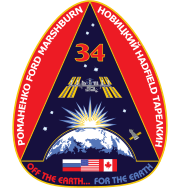 Promotional Poster | |
| Mission type | ISS Expedition |
|---|---|
| Expedition | |
| Space station | International Space Station |
| Began | 18 November 2012 |
| Ended | 15 March 2013 |
| Arrived aboard | Soyuz TMA-06M Soyuz TMA-07M |
| Departed aboard | Soyuz TMA-06M Soyuz TMA-07M |
| Crew | |
| Crew size | 6 |
| Members | Expedition 33/34: Kevin A. Ford Oleg Novitskiy Evgeny Tarelkin Expedition 34/35: Thomas H. Marshburn Chris A. Hadfield Roman Romanenko |
 Expedition 34 mission patch  (l-r) Novitskiy, Ford, Tarelkin, Romanenko, Hadfield and Marshburn | |
Expedition 34 was the 34th long-duration expedition to the International Space Station (ISS). It began on 18 November 2012 with the departure from the ISS of the Soyuz TMA-05M spacecraft, which returned the Expedition 33 crew to Earth.
Crew
| Position | First Part (November 2012) |
Second Part (December 2012 to March 2013) |
|---|---|---|
| Commander | Second and last spaceflight | |
| Flight Engineer 1 | First spaceflight | |
| Flight Engineer 2 | Only spaceflight | |
| Flight Engineer 3 | Second spaceflight | |
| Flight Engineer 4 | Third and last spaceflight | |
| Flight Engineer 5 | Second and last spaceflight | |
Mission objectives
Some of the science objectives included investigations of the human cardiovascular system in space, studies on fish and their sensation of gravity, and the impacts of solar radiation on Earth's climate. During the expedition, the robotic platform Robonaut, a humanoid robot test platform, continued testing.[3]
References
- ^ NASA HQ (2010). "NASA And Partners Assign Crews For Upcoming Space Station Missions". NASA. Retrieved 8 July 2010.
- ^ NASA. "NASA and Its Partners Announce a New Space Station Crew". Retrieved 2 September 2010.
- ^ Alan Taylor (2013). "The International Space Station: Expedition 34". The Atlantic. Retrieved 29 March 2014.
External links


